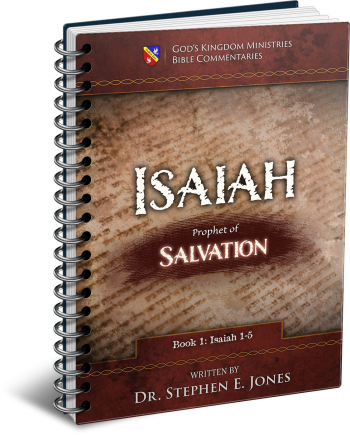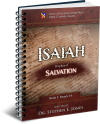Latest Posts
View the latest posts in an easy-to-read list format, with filtering options.

Isaiah is the prophet of Salvation. He is also known as the truly "Universalist" prophet, by which is meant that He makes it clear that salvation is extended equally to all nations and not just to Israel. He lived to see the fall of Israel and the deportation of the Israelites to Assyria, and he prophesied of their "return" to God (through repentance). He is truly a "major prophet" whose prophecies greatly influenced the Apostle Paul in the New Testament.
Category - Bible Commentaries

Isaiah 2:1-3 looks to the far future toward the establishment of the Kingdom,
1 The word which Isaiah the son of Amoz saw concerning Judah and Jerusalem, 2 Now it will come about that in the last days the mountain of the house of the Lord will be established as the chief of the mountains, and will be raised above the hills, and all the nations will stream to it. 3 And many peoples will come and say, “Come, let us go up to the mountain of the Lord, to the house of the God of Jacob, that He may teach us concerning His ways and that we may walk in His paths.” So the law will go forth from Zion and the word of the Lord from Jerusalem.
This is an early picture of what the prophet will describe later in Isaiah 56:7, 8, where he sees people of all nations coming to worship in the temple of God. “For My house will be called a house of prayer for all the peoples,” the prophet proclaims. He echoed the prayer of Solomon at the dedication of the temple in 2 Chron. 6:32, 33,
32 Also concerning the foreigner who is not from Your people Israel, when he comes from a far country… when they come and pray toward this house, 33 then hear from heaven from Your dwelling place and do all according to all for which the foreigner calls to You, in order that all the peoples of the earth may know Your name and fear You as do Your people Israel, and that they may know that this house which I have built is called by Your name.
Both Solomon and Isaiah were farsighted enough to overcome the common view that local gods ruled certain portions of the earth. They also countered the narrow nationalism of the Jews in Jesus’ day, who had built a dividing wall in the outer court to keep women and gentiles from approaching God too closely. Such a wall was never commanded either to Solomon or to Zerubbabel but had been included in Herod’s reconstruction of the second temple just a few years before Jesus was born.
Jesus Himself abolished that dividing wall, Paul tells us in Eph. 2:14-16, not literally, but spiritually. The New Covenant system of worship was to be in one accord with the mind of God as expressed by Solomon and Isaiah. As we see especially in the book of Acts, there were to be no second-class citizens of the Kingdom.
The only distinction is between rulers and citizens, that is, overcomers and believers in general. The rulers are called to defend the rights of all men to approach the throne of grace boldly (Heb. 4:16) and to teach believers the ways and laws of God.
“In the last days,” the prophet says, the place of worship will be in “the mountain of the house of the Lord.” While he uses the metaphor of a physical mountain (Hebrew: har), he uses the term prophetically to refer to the rise of God’s house above all the temples of other gods which had been built in “high places.” In other words, the people in the latter days were to recognize the house of God as the true place of worship, for it was to rise above all other high places.
Meanwhile, however, Solomon’s temple was to be destroyed. A second temple, built by Zerubbabel and reconstructed by Herod, was also destroyed in 70 A.D. Many prophecy teachers expect a third physical temple to be built in Jerusalem in the near future. If it is built, it will again be destroyed for the same reasons that the earlier temples were destroyed, because the temple that God now inhabits is not a physical temple in Jerusalem but a new temple made of living stones, described in Eph. 2:21, 22,
21 in whom the whole building, being fitted together, is growing into a holy temple in the Lord, 22 in whom you also are being built together into a dwelling of God in the Spirit.
We must therefore interpret the prophecies of the final temple in spiritual terms, even if the prophets use physical metaphors to picture that new temple. As the prophets pieced together the truth of the mind of God, it was revealed that God forsook the temple in Jerusalem as Shiloh (Jer. 7:12, 14). When God forsook Shiloh, the glory departed and never returned to that location. Ezekiel saw the glory depart from the temple in Jerusalem (Ezekiel 10:19; 11:23).
Jeremiah later expanded his revelation to include the entire city of Jerusalem itself. He compared its destruction to the smashing of an earthen jar in the valley of Ben-hinnom (Greek: Gehenna), as we read in Jer. 19:10, 11,
10 Then you are to break the jar in the sight of the men who accompany you 11 and say to them, “Thus says the Lord of hosts, ‘Just so will I break this people and this city, even as one breaks a potter’s vessel, which cannot again be repaired; and they will bury in Topheth because there is no other place for burial. 12 This is how I will treat this place and its inhabitants,’ declares the Lord, ‘so as to make this city like Topheth’.”
The prophecy applies to “this people and this city,” i.e., to Jerusalem and its inhabitants. Topheth means “burning,” and so he prophesies the burning of the city. Yet more importantly, the city was to be unrepairable. When Babylon destroyed the city in 586 B.C., it was later repaired. When Rome destroyed the city in 70 A.D., it was repaired again. The city has been destroyed many times, but it has always been repaired.
The city is with us even today. Hence, Jeremiah’s prophecy applies to a future destruction of Jerusalem. The previous destructions were just previews, pattern setters, and warnings of coming events.
These other prophecies must be taken into account if we are to understand Isaiah’s words. Isaiah prophesies of Jerusalem but does not distinguish between the two Jerusalems. He prophesies of the house of the Lord but does not tell us the type of house that will be established in the latter days. For these answers we must look to other prophets and to the New Testament writers who draw a clear distinction between the earthly and the heavenly temples and cities.
Isaiah tells us that “the law will go forth from Zion,” the city of David (2 Sam. 5:7), which represents the seat of government in Jerusalem. Zion is Tsiyown, from tsiyah, “dryness.”
Once again, Scripture uses homonyms to compare and contrast parallel things. In this case Zion is compared to Sion (Heb: Siyon, “lofty, lifted up”), which is Mount Hermon (Deut. 4:48). Sion does not come into prominence until Jesus went to its summit to be transfigured. It then became the seat of government for His Kingdom.
The problem is that the Greek spelling of Zion and Sion are the same, and many translators did not understand the prophetic difference between the two. So Heb. 12:22, KJV reads,
22 But ye are come unto mount Sion and unto the city of the living God, the heavenly Jerusalem, and to an innumerable company of angels.
Yet the NASB reads,
22 But you have come to Mount Zion and to the city of the living God, the heavenly Jerusalem, and to myriads of angels.
Which, then, is “the city of the living God?” Which is “the heavenly Jerusalem?” Is it Mount Zion in Jerusalem where David ruled, or is it Mount Sion, the place where Jesus was transfigured?
It should seem obvious that Mount Zion is not the heavenly Jerusalem, for Paul makes it clear that “the present Jerusalem,” that is, the earthly city, is Hagar, not Sarah (Gal. 4:25), while “the Jerusalem above” is our mother (Gal. 4:26).
Zion, then, was the Old Covenant mother of Judaism, whereas Sion is our New Covenant mother. The children of Judaism are children of the flesh (Gal. 4:29), that is, spiritual Ishmaelites who are not the inheritors of the Kingdom. As New Covenant believers, we are “like Isaac” who inherit and receive the promises of God (Gal. 4:28).
The transfer of the seat of government was prophesied by David himself in Psalm 68:15-18,
15 A mountain of God is the mountain of Bashan [i.e., Hermon]; a mountain of many peaks is the mountain of Bashan. 16 Why do you [Hermon] look with envy, O mountain with many peaks, at the mountain [Zion] which God has desired for His abode? 17 The chariots of God are myriads, thousands upon thousands; the Lord is among them as at Sinai, in holiness. 18 You [Jesus and Mount Hermon] have ascended on high, You have led captive your captives; You have received gifts among men, even among the rebellious also, that the Lord God may dwell there.
David calls Mount Hermon “a mountain of God,” and carries on a conversation with that mountain. There is no need for you to be envious, he says. You have many peaks, not just one, for you are an entire mountain range. God has desired, for the present, to dwell in Zion. Yet You, as the seat of Christ’s government and identified with Christ Himself, have ascended on high, led captive your captives, and received gifts among men—even “the rebellious also.”
For what purpose? These have all come to Hermon, giving gifts to Christ, its King, “that the Lord God may dwell there,” that is, at Mount Hermon. So Heb. 12:22 tells us that we, as believers in Christ, being formerly “rebellious” and lawless, now come to Mount Sion, or Hermon, to the seat of the heavenly Jerusalem. The peaks of Mount Hermon are far loftier and more majestic than Mount Zion.
In other words, David tells Mount Sion, “Do not be envious of Zion, because your day will come. My kingdom is a single mountain; yours has “many peaks,” because, as Dan. 2:35 tells us, the stone cut out of the mountain without hands will become “a vast mountain range” that “fills all the earth” (Concordant Version).
Hence, Zion was eventually to dry up, as its name indicates, while Sion was to remain “lifted up” in glory as the seat of government for the heavenly Jerusalem. If we lift up our mother, Sarah, we will honor her according to the Fifth Commandment, “Honor your father and your mother” (Deut. 5:16). Our own identity depends on which mother we claim, lift up, and honor.